When we drive through most towns in America, past businesses and through housing subdivisions, we’re likely to see similar plants from landscape to landscape. I’m not sure if contractors just love their trusted standbys, or if homeowners like the look and ease of plants they often see. I’m talking about hosta, barberry, Bradford pear and others I’ll explore in a moment. Some of these are certainly tough, low-care plants that make gardening easier, but what’s the fun in using the same plant over and over? And what happens when we find out that some of these plants are also invasive?
If we all like the look of these exotic plants, why can’t we use similar-performing natives that support a greater diversity of insects, birds and more? Without native plants, we lose all kinds of butterflies and bees that have adapted and co-evolved to need the natives. Are you ready for easy-care and attractive alternatives that just might enliven your landscape with new wildlife?
Below is a short list of native plants that look similar to the nonnative exotics they are replacing and will thrive in almost exactly the same conditions.
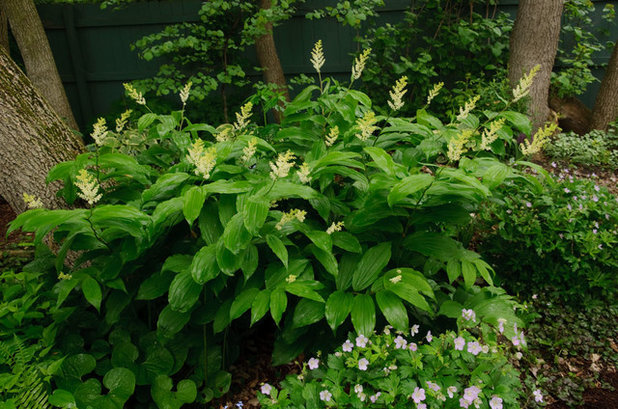
Barbara Pintozzi
Hosta AlternativesThe great thing about hostas (
Hosta spp) is that you can leave them alone almost forever. Unfortunately, no native insects can raise their young on its leaves, and just a small contingent of the insects frequent its blooms. With hostas used so frequently in gardens today, there must be one for nearly every human in the world.
Try native
Solomon’s plume (
Maianthemum racemosum, syn.
Smilacina racemosa) instead. It spreads slowly, blooms in late spring, likes medium to dry soil and gets about 2 feet tall. It’s native from Minnesota to Arkansas and east, and will support more wildlife than hosta — plus, it’s just as carefree.
Shown: Solomon’s plume (
Maianthemum racemosum)
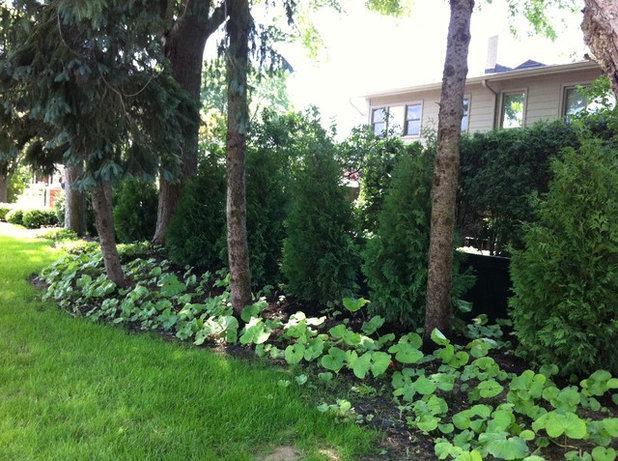
Landforms
Choose
wild ginger (
Asarum canadense) if you prefer thicker leaves and a lower habit. Plus, deer don’t like it, and pipevine swallowtails use it as a host plant. With a height of just 6 to 12 inches, and preferring a medium soil in shade, it is pretty easy to care for. It’s native from Minnesota to Mississippi and east.
You might also consider wild geranium (
Geranium maculatum) as an attractive and quick-spreading ground cover. It blooms anywhere from late spring to early summer and loves dry soil in full shade.
Shown: Wild ginger (
Asarum canadense)
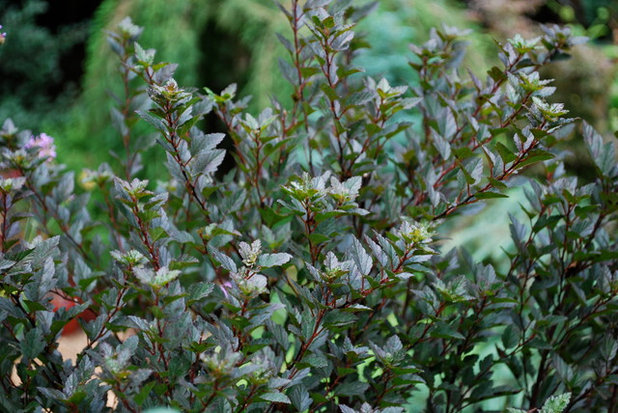
Jay Sifford Garden Design
Japanese Barberry AlternativeJapanese barberry (
Berberis thunbergii) is prized for its structure, color and low care, but its thorns and lack of wildlife value are not so great — and it’s becoming a menace in the wild, especially in areas like the Northeast.
A couple of new ninebark (
Physocarpus opulifolius) cultivars have come on the scene; not only do they have dark foliage like barberry, but their late-spring to early-summer blooms are real butterfly and bee magnets. In this image you can see ‘Little Devil’. It grows best in medium soil in full sun, reaching about 3 to 4 feet tall and wide. Once established it can take some periods of drought. You might also try ‘Tiny Wine’. Ninebark is native from central and eastern Canada south through North Dakota into Oklahoma, and east to Florida and New England.
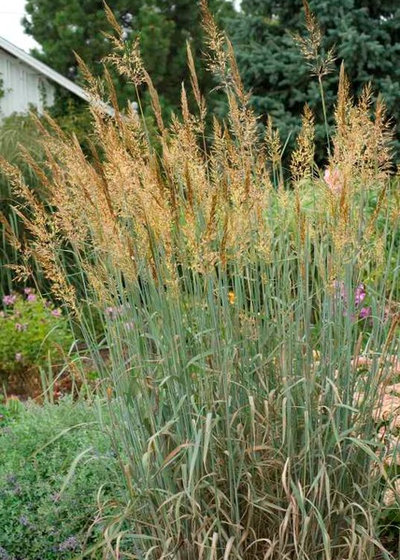
Missouri Botanical Garden
Miscanthus AlternativeMiscanthus (
Miscanthus spp) has big, fluffy plumes in fall that can last into winter, but it’s having some invasiveness issues
in parts of the U.S.
Try Indian grass (
Sorghastrum nutans), a tallgrass-prairie native that reaches 3 feet wide and up to 6 feet tall while in bloom. Medium to dry soil in full sun is great for this native, whose foliage often turns a nice rainbow of colors in late fall. The seed head plumes will last almost the entire winter, and it holds up well to snow — just like Miscanthus. Our native grasses are host plants to all kinds of moths and butterflies.
Shown: Indian grass (
Sorghastrum nutans)
Powell Gardens, Kansas City's Botanical Garden
Burning Bush AlternativesBurning bush (
Euonymus alatus) is commonly reported as invasive in many parts of the country — often far afield from our gardens, out into more natural and wild areas, where birds disperse the seeds. When we look for native alternatives, however, we don’t have to sacrifice burning bush’s gorgeous fall color.
Eastern wahoo (
Euonymus atropurpureus) is a large shrub or small tree that grows to about 15 feet tall and wide. Dry to medium soil in full sun is best, but it is fairly adaptable and can handle up to 50 percent shade. Little red flowers appear in May to June, and birds gobble up the fruit at the end of the season. Wahoo is native from Minnesota to northern Texas and east.
Shown: Eastern wahoo
(
Euonymus atropurpureus)
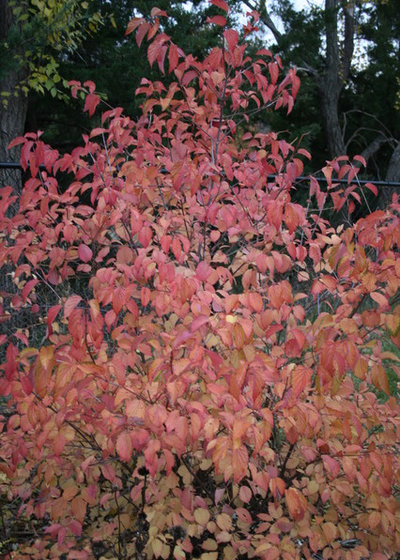
Benjamin Vogt / Monarch Gardens
Southern arrowwood(
Viburnum dentatum ‘Red Feather’), also called arrowwood viburnum, is one of my favorite medium-size shrubs for medium to dry soil in full to partial sun. It’s native from Maine to Florida and west to eastern Texas. At about 8 to 10 feet tall and wide at maturity, the cultivar ‘Red Feather’ puts on a great fall show. Clusters of white flowers appear in May and June, followed by midsummer blue berries the birds devour in a day or two. (Note that you need two different cultivars of arrowwood to get berry production — ‘Blue Muffin’ is a good choice.)
For wetter soils you might also try
Virginia sweetspire (
Itea virginica), which has stunning red foliage in autumn and white bottlebrush blooms in summer. It’s native from the Great Lakes region south to Texas and east.
There are many red and black
chokeberries (
Aronia spp) that also have some top-notch fall color, spring flowers and winter berries. Why plant burning bush when you can plant these wildlife-benefiting and noninvasive natives?
Shown: Arrowwood viburnum (
Viburnum dentatum ‘Red Feather’)
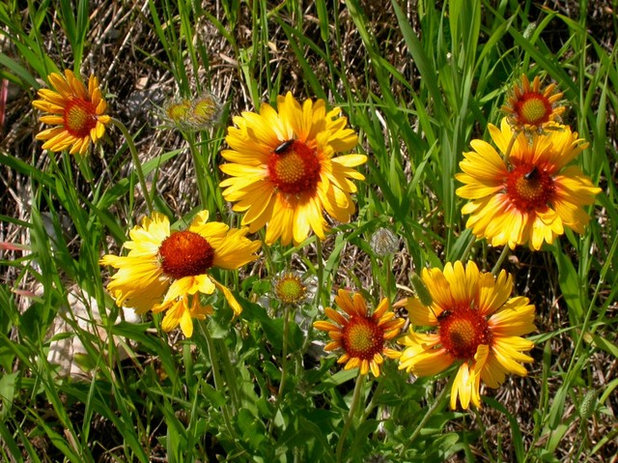 Daylily Alternatives
Daylily AlternativesDaylily (
Hemerocallis spp)
is an easy plant to grow, but we see it everywhere — and I mean everywhere (it’s a lot like hosta in that way). The deep-throated flowers are not very appealing to the majority of insects, and insects are vital to birds, frogs, crops and more.
Blanket flower (
Gaillardia aristata) grows in dry, sunny soil and is diminishing in its native range of the northern Plains, Rocky Mountains and Pacific Northwest. Plants will bloom all summer long and reach 1 foot to 3 feet tall, depending on moisture. Blanket flower is a favorite nectar source for the threatened Dakota skipper butterfly.
Scaly blazingstar (
Liatris squarrosa) is an underused, carefree native that thrives in dry, sunny conditions, like most daylilies. It forms a clump that’s about 2 feet wide and 2 to 3 feet tall, and is native from Nebraska to Virginia and south from Georgia to Texas and Oklahoma.
Shown: Blanket flower (
Gaillardia aristata)
Photo by Matt Lavin
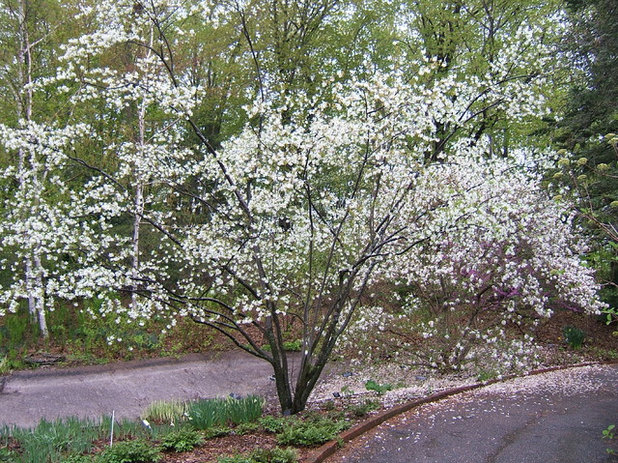
Julie Weisenhorn, University of Minnesota
Bradford Pear AlternativesBradford pear (
Pyrus calleryana ‘Bradford’) has gotten out of hand for many, popping up in woods and meadows everywhere.
Instead, consider our native serviceberries (
Amelanchier spp).
Allegheny serviceberry (
Amelanchier laevis). Like its relative downy serviceberry (
A. arborea), it produces brilliant white flowers in late spring and loads of red to purple berries in summer that are quite tasty to both humans and birds. Fall color can be great, too. Serviceberry grows to about 15 to 30 feet tall and wide, preferring moist to slightly dry soil in sun to partial shade. It’s native from Minnesota to Alabama east and north into Canada.
Chokecherry (
Prunus virginiana)
might be a great drought-tolerant alternative to Bradford pear, particularly the cultivar ‘Red Select’. It has white spring blooms and bright red fall color after its green leaves turn maroon. There’s no reason we need to keep planting Bradford pear when we have so many attractive and adaptable native alternatives.
Shown: Allegheny serviceberry
(
Amelanchier laevis)
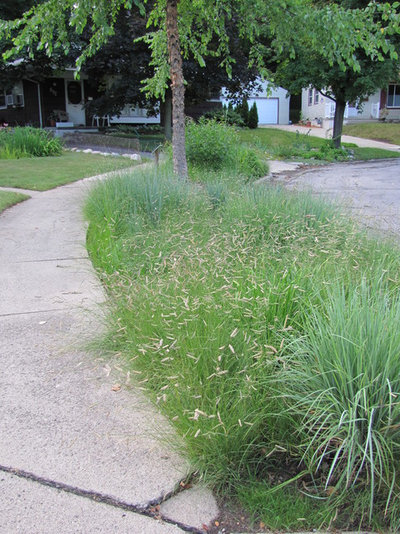
Creating Sustainable Landscapes, LLC
Lawn AlternativesI consider lawn to be a nonnative and invasive phenomenon. The idea of lawn comes from England, where cooler and wetter temperatures make it far more practical to grow than in most of the United States. Right now the Southwest and California are experiencing its impracticality firsthand.
Blue grama grass (
Bouteloua gracilis) is a superb drought-tolerant lawn alternative. You can keep it trimmed to look like a traditional lawn, or let it grow and see the awesome seed heads, which reach about 12 inches tall in late summer. Plant it in a hell strip, as in this image, and leave it alone. It’s native to the High Plains, Mountain West and Southwest, from Minnesota to Texas west to Idaho and Nevada and into Southern California.
Of course, there’s also a whole smorgasbord of sedges (
Carex spp) to choose from.
Both blue grama and many of the sedges can handle moderate foot traffic.
Tell us: What other native plants would you suggest to replace common exotics?





